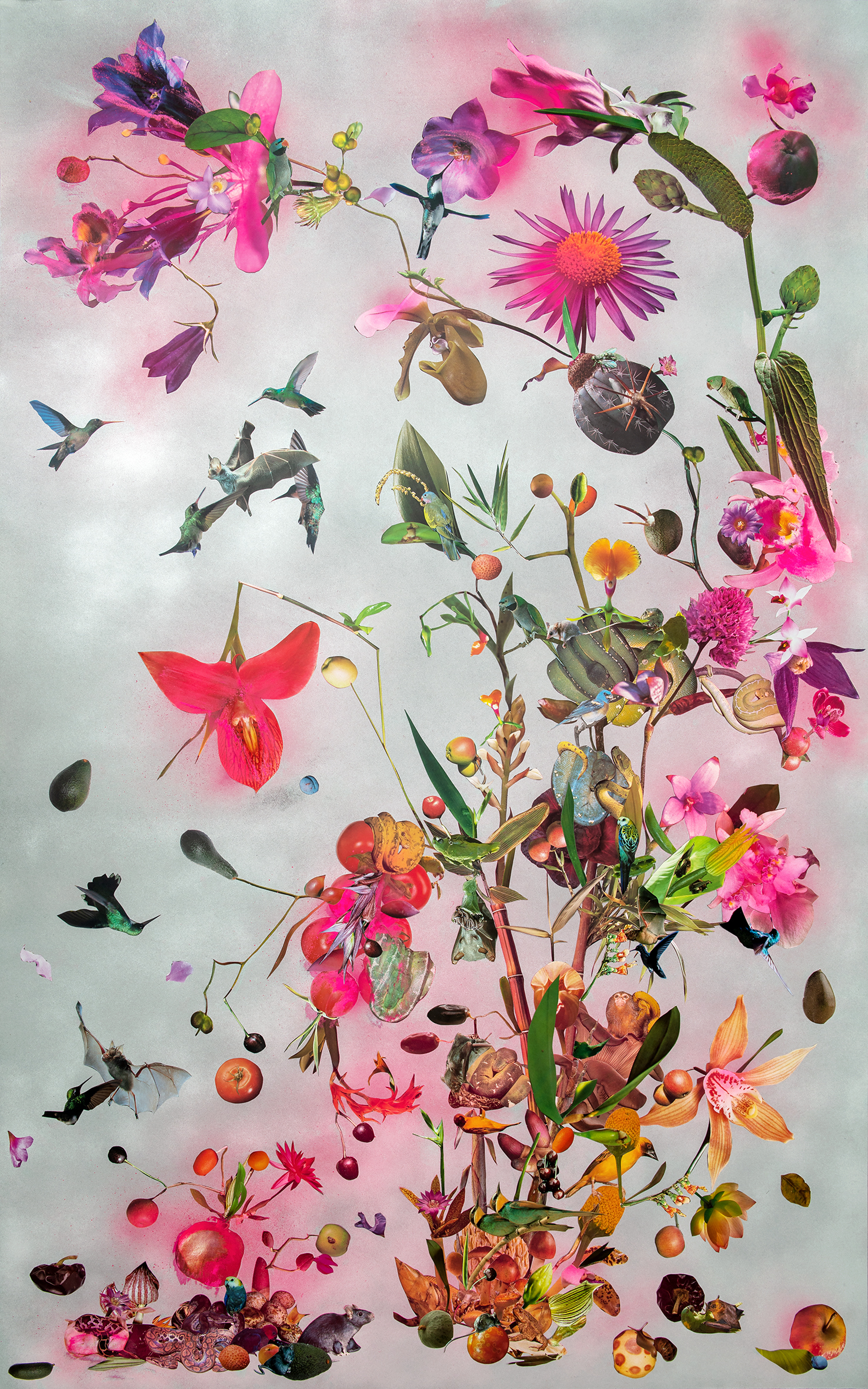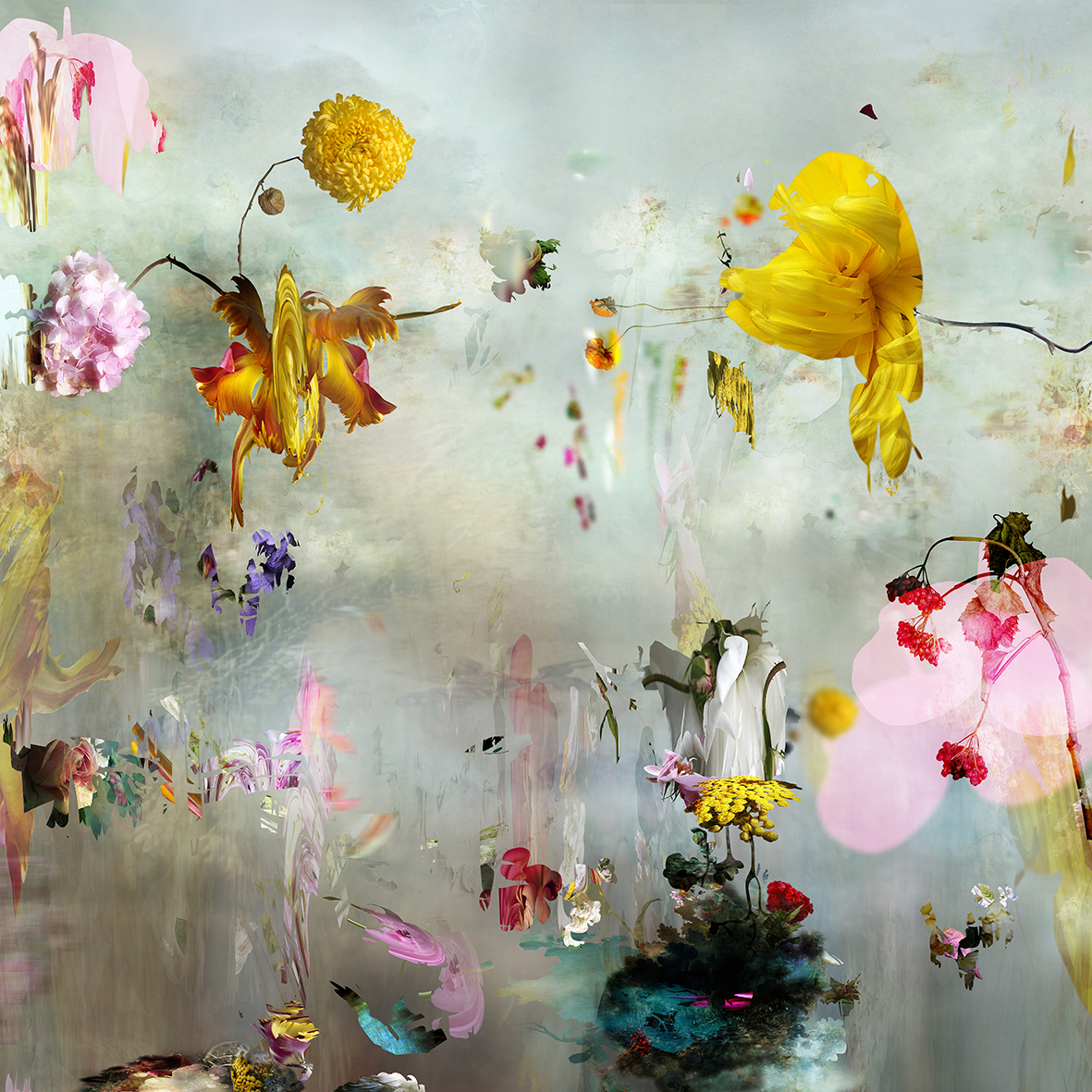DIGITAL GARDENS
Three talented artists from Belgium and Switzerland are known
for the creation of magical digital gardens. Each of them has its own secret.
Vogel und Pflanze
The pictures of the collages are taken from books. But photographing is an important part of our work too.
LB: You have been working together for over a decade. How is it working with your brother? You must inspire each other?
HH: We both worked as artists, but never together. Then we decided to join forces and created a collective “huber.huber”, what was a big step. We destroyed all our works and looked for a new studio. Working in a team is more fun, you also feel more powerful.
It helps when you face a very stressful art market.
World of Flowers by Markus and Reto Huber, Huber.Huber @huber.huber
Zurich, Switzerland
La Botanica: You have an impressive portfo- lio that includes collages, paintings, installa- tion, books and sculptures. How do you make a decision about what your next collection will be? Do you find it or it “finds” you?
Huber.Huber: We are inspired by the actions of human beings. That means the ideas find us in everyday life. There is no lack of new ideas, we work side by side on many projects.
LB:You use a lot of flora and fauna elements in your art. Do you always carry your camera around and take pictures of nature?
HH: In fact, we are a lot in nature. We love to grow our own vegetables, in the summer we swim in the river next to the studio, in au- tumn we search for mushrooms in the forest.
Tree of knowledge
New Rome 01
LB: Your art has a strong feeling of mystical gardens and fairy tales. Do you have a story about a flower?
IM: What we usually like in fairy tales is the moment when the big bad wolf appears. It is the moment of the reality twist, when a dark zone lights up, all of a sudden, and allows something yet unrevealed to emerge. It is the transition from smoothness to crookedness, the swing from lightness to darkness, the revelation of a different reality through the gloom. If there is a link between fairy tales and my work, it is precisely in that aspect. That’s why my favorite flower is a white lily. Because, it’s a symbol of purity, because it has the most sensual and diabolic smell. Because of Laurie Anderson’s song «White Lily.»
LB:You have a unique technique in mixing colors and textures. Is your mood reflected in your art, your color selection?
IM: Well, yes, it is. Or maybe reverse, my work helps me find out which mood I am in. What comes first? The art or the mood? It’s sometimes difficult to understand. That’s why it’s important for me to work a lot. Through the process of working you learn about yourself and that knowledge helps you create better art.
Inland photography and disordered landscapes
by Isabelle Menin @isabelle_menin_photography
Brussels, Belgium
La Botanica: You have transferred your skill of oil painting to digital photography. It is a very impressive move. Did it open possibili- ties to create new vibrations?
Isabelle Menin: Digital technology has been a total release. The “Undo” click is one of the greatest inventions ever!
At the time, it was a brand-new device, and
it was so fascinating, it felt like the ballast of the art, my education, my analysis, the critical distance was removed from me. It was defi- nitely a bewitching tool, but it also worrying because of the unlimited possibilities of manipulation it provided. It was so fast, so vertiginous that you could hardly keep your path straight and narrow.Working in digital medium allowed me to push my limits, to find a much wider sphere of activity, where things tied up fluidly and where actions were reversible.
New Rome 07
“As well as the universe, the order in life and nature came out of chaos. What keeps us alive is the pulsation of our inner light. My radiation, my shine, paves the way for my growth.”
The Beacon
Supernatural Landscapes
by Jesper Krijgsman @jesper.krijgsman Zurich, Switzerland
La Botanica: What is the idea behind the mystical gardens? In what way is this concept reflected in your artworks?
Jesper Kingsman: I’ve always been fascinated with visual storytelling and especially digital image editing techniques. I’ve also discov- ered an inner passion for nature. During my travels, I’ve encountered places that truly felt enchanting. I believe that this magical part of nature is something that is often overlooked these days.For example, the distinctive look of a particular plant is the result of its evo- lutionary process, or the behavior of certain animals is the result of the adaptation to their environment. Although there are scientific explanations
for these qualities, I’m often amazed by its cre- ativity and diversity. I try to reflect this inge- nuity in my work and explore realms in which this mystical inventiveness is untouched
and amplified. In my process of editing my photographed material and placing it onto my digital canvas, I try to let go of everything around me and place my elements based
on my intuition. Basically, I am mirroring a landscape that starts to grow: it often changes its course based on its interactions and takes its time before it gets finished.LB: You are a professional graphic designer. How does the process of art-making connect and interact with this occupation?
JK: My profession of a graphic designer goes hand in hand with my artistic journey. I’m used to working with image editing programs on a daily basis. In the process of making my early graphic design work, I learned that I lean towards complex design rather than a minimalistic approach. This tendency didn’t always help me in the making of the graphic work, I was often asked to reduce details
in the designs I made. I think that those commentaries fueled my desire to work on something without any constraints, some- thing opposite of minimalism. I challenged myself to work with unconventional material in the digital world.
Today I feel that my work is perfectly bal- anced between the job of a graphic designer in a communication agency and my own projects.
LB: What is your favorite part about working with flowers?
JK: During my process of photographing plants and animals, I get an intimate look
at its properties. I get really excited when in the process of looking for new material to work with, I discover some unique shapes and colors that I have never noticed before. Since everything in nature serves a purpose,
I start to imagine how this living being has developed itself into what it is today. I try to convey an emotion in my work. I challenge myself to do this solely using natural and organic material. I believe that people have an emotional reaction to plants and flowers as soon as they realize it is living matter, that they have to overcome obstacles just as we do. In my work, I try to celebrate the diversity of all that is living, not just it’s beauty, but it’s intelligence and ingenuity.
Emergence
“It took millions of years for life to emerge from one cell in a sea. This is what connects every- thing in our world. Our unity allows the emergence of new phenomena. We’ve developed social systems to maintain order and develop as a species. How- ever, we are all connected on this planet. Plants and animals, in many ways, function similarly to us. It seems that they are aware that they are a part of a whole being, greater than the sum of its parts. With our compassion for one another, we are able to coexist and create ways for the appearance of new beautiful things.”
Interview by Contributing Editor: Olya Titova @collage_department
Represented by Muriel Guépin Gallery, NYC. www.isabellemenin.com
Represents himself. www.jesperkrijgsman.com






